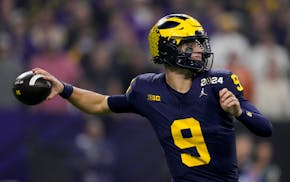The position of big-league hitting instructor might be the most mysterious coaching job in sports.
Paul Molitor and Rod Carew, two of the smartest and most scientific hitters in baseball history, were fired as hitting coaches. Under Joe Vavra, who never played in the big leagues and compiled a .288 batting average in the minors, the Twins won two MVP Awards and three batting titles, thanks to Justin Morneau and Joe Mauer.
Desperate to find the right defibrillator to shock the team into offensive competence, the Twins moved Vavra from hitting coach to third base coach before last season, and promoted Tom Brunansky to Vavra's old post.
Brunansky had much to recommend him — big-league success, a commanding personality, ties to the organization with which he helped win a World Series, and familiarity with the Twins' young players.
In Brunansky's first year on the job, the Twins went backward, from troubling to pathetic. In 2013, they offered a rare combination. They didn't hit for power. They didn't make contact. They didn't succeed in the clutch. They weren't adept at small ball. They were a lineup without strengths.
While the front office aggressively pursued pitching to fix the Twins' most important flaw, it hoped that the lineup would improve with the arrival of a few prospects and the improvement of a few other young players. In other words, Brunansky had a lot of work to do, if you believe that hitting instructors directly affect batting averages.
Through six games of the 2014 season, the lineup has offered signs of hope. When the Twins are introduced before Monday's home opener at Target Field, they may not have to adopt an NFL tactic and introduce only their defensive players.
Early-season numbers are easily skewed, but there are tangible reasons to like what the Twins have done at the plate so far.
Chris Colabello has produced five extra-base hits. He looks, in the vernacular, "hitterish." He has produced in independent ball, in the World Baseball Classic, in spring training, at Class AA and at Class AAA. If he can produce power against big-league pitching, the Twins' lineup will instantly be strengthened and deepened.
Jason Kubel is a pure hitter. The health of his legs has been the primary variable in his career. Kubel looks healthy, and has been able to turn on fastballs. He could give the Twins lefthanded pop they desperately need.
Josh Willingham looked lost, and his bat looked slow, for much of spring. Sunday, he left the game after being hit on the wrist in his first at-bat, but so far he has looked dangerous at the plate, and has displayed the ability to pull fastballs. Worries about his bat speed may have been unfounded.
Trevor Plouffe has produced home runs in spurts during his time with the Twins, but he may never before have had six games in a row with so many good at-bats before this week.
Pedro Florimon remains an easy out. Brian Dozier will have to become better at getting on base to hold down the leadoff spot. Aaron Hicks has much to prove, especially from the left side of the plate. Kurt Suzuki had a good week but does not have a history that inspires optimism about his offensive production.
The Twins' lineup is a work in progress at best, but, for a week, it hasn't produced as many unsightly at-bats and hopeless swings as it did almost every week of last season.
Maybe Brunansky got through to a few players this spring. Maybe hitting remains a mysterious endeavor that defies cause-and-effect explanations.
Here's the best "maybe" for this team:
Maybe Colabello, after succeeding at every level of baseball other than the majors, will be the first long-shot hitter to improve their lineup since Lew Ford became a folk hero in 2004.
Jim Souhan can be heard weekdays at noon and Sundays from 10 to noon on 1500 ESPN. His Twitter name is @SouhanStrib. jsouhan@startribune.com.
Souhan: Wolves deserve better challenge than soft, shallow Suns

Souhan: These seven plays showcase Wolves' new defensive fire

Souhan: Wolves fans made Game 1 special. Now bring on Game 2.

Souhan: Should Vikings even consider McCarthy in NFL draft?

